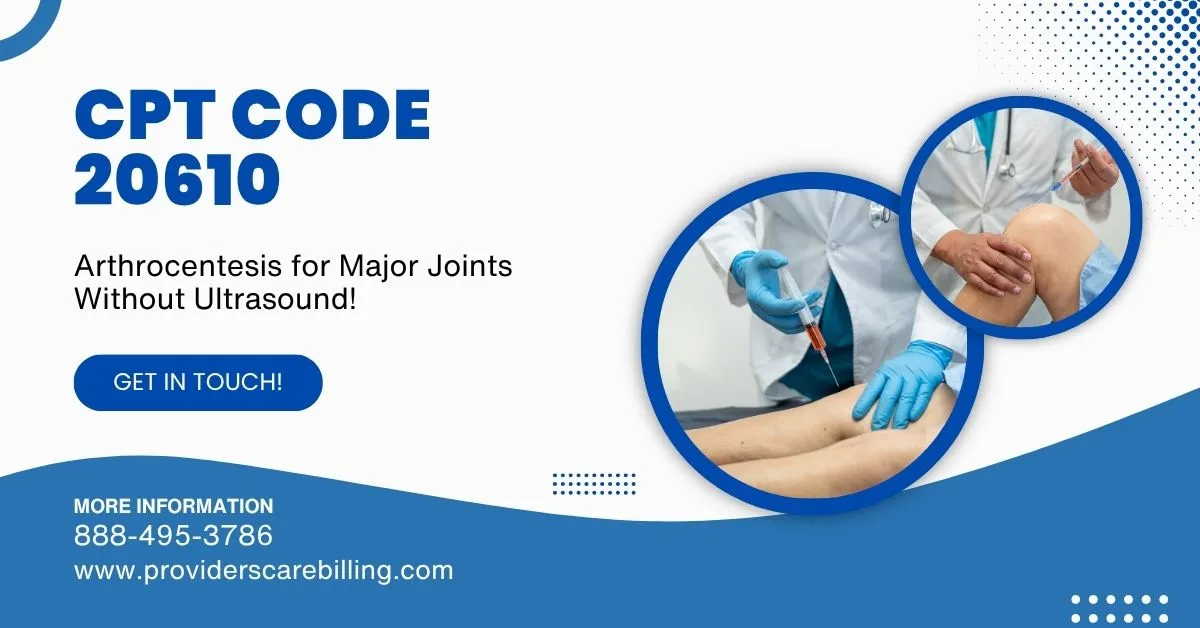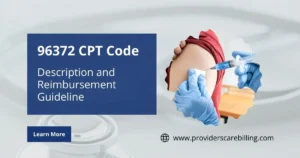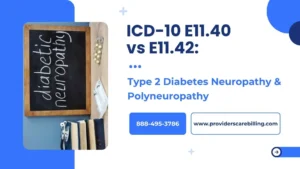Research shows that Doctors in the U.S. cperform over 1 million joint injections every year. And CPT code 20610 is the most commonly used code for this procedure. It is also commonly used for arthrocentesis (aspiration or injection) of the major joints or bursa that is not done with ultrasound guidance.
This test is for the diagnosis and treatment of joint diseases in the fields of orthopedics, rheumatology, and general medicine. Knowledge is very important for physicians and billers. In this blog post, we investigate what the 20610 CPT code entails, when to use it, and other important information related to it.
What is Arthrocentesis (CPT 20610)?
Arthrocentesis is the placement of a sterile needle into a joint or bursal space through which synovial fluid is removed or therapeutic medication is injected. It provides relief from pain by aspiration of painful joints, also helps to minimize inflammation, increase range of motion, and aspirate fluids for examination in the laboratory.
This arthrocentesis CPT code refers to arthrocentesis over a larger joint or bursa, like the knee, shoulder, or hip, with ultrasound not being used.
When is CPT 20610 Used?
The procedure code 20610 is used for diagnostic as well as therapeutic means.
For diagnostic purposes, a provider may aspirate fluid to exclude alternative diagnoses such as septic arthritis, gout, pseudogout, or other inflammatory joint conditions. Synovial fluid can be sent to analyse crystals, cells, and bacteria.
Injections of corticosteroids, hyaluronic acid, or anesthetics can also treat pain and inflammation that result from osteoarthritis, rheumatoid arthritis, and bursitis. In many cases, people get relief just from aspiration, as it will drain out the excess joint fluid, which is causing pressure. So, this CPT code for injection of medication proves as a pain-reliever.
Difference between CPT 20610 and Similar Codes
Many other CPT codes are similar to 20610. We have already provided the description of CPT code 20610. Here are other CPT codes that specialists typically use when treating patients with these conditions, depending on the size and location of the joint or bursa being aspirated and whether ultrasound guided the procedure.
- 20600 is for the arthrocentesis of the small joints or bursa, including but not limited to fingers and toes. It is indicated when there is no image guidance and the anatomic target is not significant.
- CPT code 20605 description includes intermediate joints or bursae that are based in the wrist, ankle, and elbow. And the most important thing is that this is used only when ultrasound is not used.
- Conversely, CPT 20606 describes the same process as 20600 but also describes the application of ultrasound guidance, including documentation of real-time imaging. So, if you perform ultrasound guidance of aspirating or injecting a small joint, CPT 20606 is your go-to code.
- 20612 CPT code is another code which is specifically for the aspiration or injection of ganglion cysts. These are cysts containing liquid and often appear on the wrist, foot, or hand. This code should not be reported with 20610, which is for intra-articular or bursal injections.
- Finally, CPT code 17250 does not involve joints. This is a term referring to chemo cauterization of granulation tissue, a process one would generally do for wound care or treating proud flesh/sinus tracts. Although it is a minor maneuver similar to arthrocentesis, it represents no joint therapy.
Procedure Overview for CPT 20610
Arthrocentesis is generally done on an office basis or as an outpatient procedure. After the procedure has been described and consented to, the provider prepares the area and uses a local anaesthetic. A clean needle is then inserted into the joint.
If aspiration is indicated, synovial fluid is removed. It can be clear, cloudy, or bloody and assists in diagnosing an array of joint abnormalities. If therapeutic injection is planned, such as injection of steroids or visco-supplements, these are injected into the joint.
Joints commonly treated in the 20610 CPT code that include the knee (the most common), shoulder, hip, and subacromial bursa. Based on size and clinical situation, patients with larger anatomy may also need this code for the elbow.
Proper Documentation
Clear and comprehensive documentation is required for a claim filed with code 20610 to be valid and reimbursed. The provider should record.
- The treated joint or bursa, and sides (right or left)
- If the intervention had been aspirate, injected, or both
- The name, dose, and route of medication given
- That consent was implied.
- The condition indicating prosthetic or native joint aspiration: pain, swelling, or concern for joint infection
- Any pertinent findings or immediate feedback from the patient
If complete documentation is not made, payers can decline coverage or audit, coordinately, when both an E/M service and procedure are reported on the same date.
Modifier Usage for CPT 20610
CPT code 20610 can also be reported with the modifiers to provide a clear description of unique situations. The most common 20610 CPT code modifiers are:
- RT or LT to specify if the operation was carried out on the right or left joint.
- Modifier 50 for bilateral (e.g., both knees) procedure.
- Modifier 59 to indicate separate procedural services when multiple joints are treated in the same session.
- Add modifier 25 to the M/EM code if the E/M service is separately identifiable and contributes to the decision to perform arthrocentesis.
Code 20610 is a unilateral injection; only one unit should be billed per joint, regardless of whether aspiration and injection are performed at that site on the same day.
Injectables and HCPCS codes
Any anesthesia that is given at the time of the procedure can be accounted for by billing HCPCS J-codes separately. For example:
- J3301 is for Triamcinolone acetonide (Kenalog), a typical corticosteroid.
- J7321 is appropriate for using hyaluronic acid injections for osteoarthritis.
- J1885 would be used for ketorolac (nonsteroidal anti-inflammatory).
NDC (National Drug Code), lot number, and the dose administered should also be billed by providers to guarantee full and accurate payment.
Cost Recovery Information
This CPT arthrocentesis code is covered by commercial payers, Medicare, and Medicaid, assuming the procedure is medically necessary. Reimbursement rates may vary by payer, site of service, and location.
Outpatient clinic-based procedures are relatively better reimbursed than hospital-based procedures because the practice expense inputs are different. As always, refer to your payer-specific guidelines, particularly before authorization for injectable medications.
Reflection indicates that the denial is more likely the result of incomplete documentation, inaccurate use of modifiers, or insufficient evidence of medical necessity in the ICD-10 codes. You, therefore, assign CPT 20610 to a diagnosis close to the joint, e.g., osteoarthritis (M17.x). 11 for right knee OA), with bursitis, is necessary.
What Are the Tips for Clean Claims and Denial Prevention?
To help prevent unwarranted denials or delays in payment:
- Ensure the use of ultrasound was not performed, as this would necessitate reporting of CPT 20611 or other guided procedure code
- State medical necessity clearly in the clinical note.
- Make use of ICD-10 diagnosis codes regarding joint disorder, swelling, or pain.
- Include all applicable modifiers, especially when reporting bilateral or multi-compartment injections.
- Don’t forget to charge separately for injectable medicines.
Just as it’s crucial to understand the specific use and documentation requirements for CPT 20610, accurate coding is equally important in behavioral health settings. If you bill for mental health services, understanding time-based psychotherapy codes is essential. Here’s when to use 90836 instead of 90834 in psychotherapy billing.
Final Thoughts!
Now we can conclude that this CPT code 20610 is the main code for musculoskeletal and rheumatologic specialties. Whether you are a doctor, nurse, medical coder, or office staff member, knowing that how to use CPT 20610 the right way can help you save time, reduce stress, and make your practice run more smoothly.
It helps ensure that joint injections are done correctly, billed properly, and covered by insurance. We hope our blog post gives you the simple help you need to feel more confident about using it.




